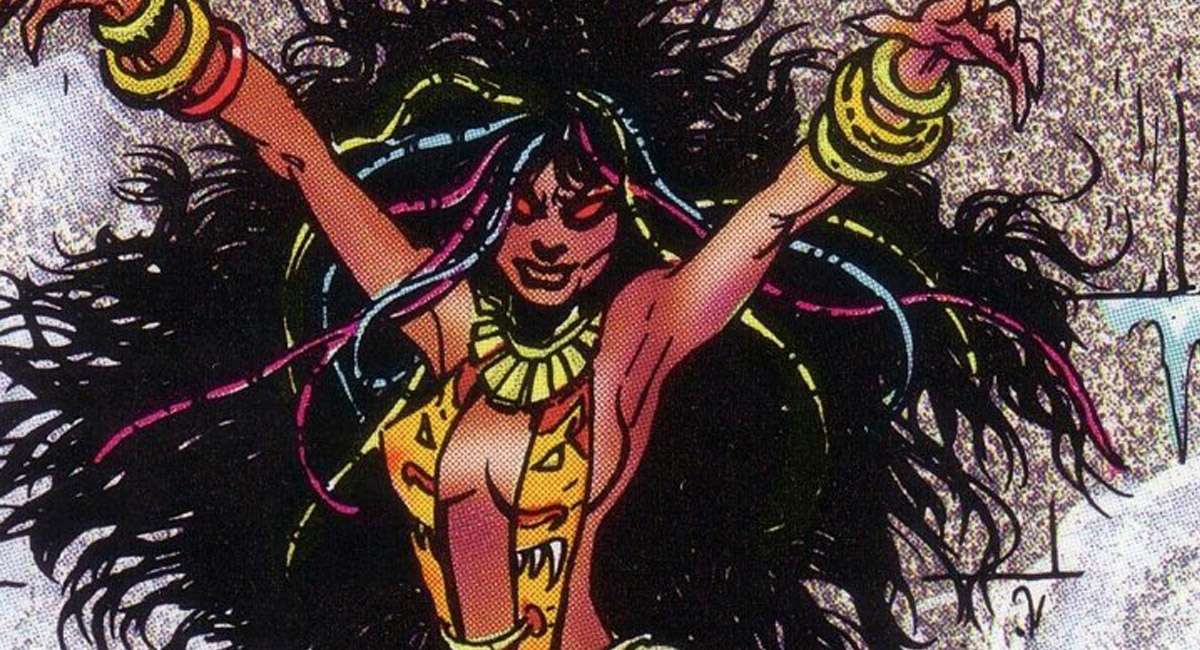
Kraven the Hunter recently cast a key character. The Spider-Man-adjacent cold-intro spinoff film, which will see former Kick-Ass star Aaron Taylor Johnson headline as one of the Wall-Crawler’s earliest comic book nemeses, reportedly cast West Side Story standout Ariana DeBose to play Calypso, Kraven’s wicked, zombie-making voodoo priestess lover. DeBose’s onscreen depiction of Calypso will stand as the most significant elevation of the somewhat obscure Spider-Man antagonist. However, the character has also conjured her own uniquely wild woes for the web-head and other Marvel heroes.
The long-gestating Kraven the Hunter movie project will join Sony Pictures’ Marvel Cinematic Universe-adjacent Spider-Man continuity, which currently consists of the Tom Hardy-starring Venom and sequel Venom: Let There Be Carnage, the upcoming Jared Leto-starring Morbius, and farther down the line, the Dakota Johnson-starring Madame Web. With the ongoing success of Spider-Man: No Way Home having made a key nod via Hardy’s mid-credits cameo, these spinoffs remain uniquely acknowledged as canon, despite the convoluted nature of their connectivity. This will likely be the case for Kraven, for which DeBose’s role as Calypso, as reported by Deadline, could prove crucial as the actress comes off a career-altering Best Supporting Actress Oscar nomination for her West Side Story breakthrough.
With that set, here are some of Calypso’s most notable (and potentially movie-influencing) aspects in the pages of Marvel Comics.
She’s Kraven’s Lady Macbeth

Calypso first appeared back in 1980 in the pages of The Amazing Spider-Man #280, created by writer Denny O’Neil and artist Alan Weiss. With a straightened hairdo, a white tiger skin top matching Kraven’s motif and tight purple pants, she was not fully realized as the wild, sultry psychopathic voodoo priestess she would eventually become. Yet, the presence of Kraven’s debuting Haitian love interest was immediately profound for the hunter, who was enjoying a period of dormancy after consistent defeats at the hands of Spider-Man.
Here, Calypso, using manipulative plays on his honor and masculinity, coaxed the calmed Kraven back into the perpetual hunt for his web-spinning quarry; a dynamic that would define the character for the first decade of her printed existence. In the case of her debut issue, she quite literally slaps Kraven back into his bellicose obsession with Spidey. Indeed, the Macbeth-like displayed dynamic would come to define the couple’s relationship, and that will likely be reflected in the film.
She Received a Tremendous Todd McFarlane Makeover
By 1990, Calypso had essentially existed as a side character intrinsically connected to Kraven, who became the center of one of comics’ darkest moments when he committed suicide in the 1987 Spider-Man storyline “Kraven’s Last Hunt.” While that development seemed devastating for Calypso’s future as a character, superstar artist/writer Todd McFarlane saw an opportunity for an astounding evolution for the cast-off. This would come about with the launch of the McFarlane-fielded supplemental title Spider-Man. There, the inaugural 5-issue arc “Torment” would see Calypso serve as the main antagonist.
This version of Calypso no longer needed scathing barbs to be manipulative, and instead wielded powerful Voodoo magic, as apparently imbued onto her through a dark ritual in which she sacrificed the life of her younger sister. Thus, Calypso resurfaced in “Torment” as a superpowered proxy for Kraven, now showcasing long, wild hair decorated with colored braids, complementing a barely there lion-skin onesie that evokes the sartorial style of her late beau. Pertinent to that tribute, her revenge-driven agenda against Spider-Man manifests a magic-powered plot that taxes Spidey physically and psychologically, primarily using the Lizard as her bewitched and enthralled savage muscle. The storyline would, however, stand as the most prominent showcase for Calypso.
She’s Also Tangled with Daredevil

A 1992 Marvel storyline would see the return of Calypso after she was presumed dead at the end of “Torment.” The two-issue arc, starting with Daredevil #310, depicted her mysterious resurfacing, now flanked by zombie servants, in New York City’s Hell’s Kitchen, where—after a brief battle in which she defeated Daredevil’s demonic evil Infinity War-born doppelganger—she enacts the agenda of experimentation with zombification on Haitian refugees.
The undead operation, designed as a dry run toward resurrecting Kraven, obviously attracts the attention of Daredevil, seeing as Calypso is carrying it out on his crimefighting patch. The Witch (as she is so nicknamed) proves to be a formidable opponent, and even temporarily turns the Man without Fear into a zombie himself. However, with the help of a repentant refugee arms dealer and the spirit of Brother Voodoo, Daredevil successfully manages to turn Calypso’s magic against her, thereby freeing the zombie-enthralled refugees in the process. This, however, would not be their last encounter, with another clash eventually occurring in 1993’s Daredevil Annual Vol. 1 #9.
She Carried Out Her Own Resurrection

Calypso returned in Web of Spider-Man Vol. 1 #109 (1994) for another vainglorious attempt to enthrall the Lizard to reattempt her “Torment” plan. However, the plot—which involved breaking into the high-security supervillain prison the Vault—clearly doesn’t go as planned after her spell to transform human alter-ego Dr. Curt Connors back into the Lizard fails to control the creature, who clearly remembers his prior enslavement and immediately inflicts a fatal slash. While her death would last for about three years, Calypso would eventually prove that she’s not one to be hindered by a silly thing like death.
Spider-Man Annual Vol. 1 (1997) saw the spirit of Calypso continue carrying out machinations through Peter Parker’s Daily Bugle colleague, Glory Grant, joined by a new possessed servant, a zombie—and not just any zombie, but the Zombie, a.k.a. Simon Garth, a 1953-era creation of writer Stan Lee and artist Bill Everett for Marvel precursor company Timely Comics; a character who would eventually become grandfathered into Marvel lore. Here, Calypso’s control of Glory, achieved through an artifact called the Amulet of Damballah (acquired on her Caribbean vacation), made her—and, by proxy, Garth—the unwilling vessel for another plot involving the zombification of innocents. While Spidey—with the help of a federal agent called Shotgun and a recovered Glory—is able to foil the plot, Calypso manages to escape in her newly magic-restored original body.
She’s Had Colorful Animated Adaptations

Of course, Calypso has surfaced across the various self-contained Spider-Man continuities of Marvel comic titles, animated shows and even video games. While a more-recent animated appearance on 2008-2009’s The Spectacular Spider-Man depicted her in a traditional manner as Kraven’s manipulative love interest, Calypso’s preceding depiction on the legendary 1994-1998 Spider-Man animated series took some rather radical, Voodoo-less liberties. Here, the show initially depicted the character as a scientist named Mariah Crawford, who, during her travels in Africa, met and fell in love with hunter Sergei Kravinoff.
However, in a backstory element unique to the animated series, Mariah saved the life of a mortally injured Sergei with an experimental serum that has been known to turn people into savage creatures. In Sergei’s case, it gives him a physical boost but affected his mind, turning him into the show’s version of the villainous Kraven the Hunter. While Mariah was a benevolent character—one who even helped Spider-Man fend off a mutation disease—she would find herself dying from a mysterious virus, inciting an eventually cured Sergei to give her the serum, which turns her into a more-savage form called… you guessed it, Calypso. Thus, to stop her rampage, Sergei uses the serum on himself to once again become Kraven, leading to a resolution in which Peter Parker/Spider-Man’s scientist colleague, Debra Whitman, develops a cure for the serum’s maddening effects, thereby allowing Kraven and Calypso to reconcile an altered existence together.
Movie Prospects

Calypso’s presence persisted in the pages of Marvel Comics, although not quite in the visually sultry form as McFarlane’s peak-industry-era reinvention. For example, in an arguable shark-jumping storyline, she would become central to a 1998-published arc in The Spectacular Spider-Man, in which she manages to inveigle Kraven’s surfaced son Alexei Kravinoff into becoming the new Kraven. Utilizing enhanced strength and healing abilities as a mutant (see what I mean about shark-jumping?) the successor attempts to carry out Calypso’s vengeance upon Spidey.
However, the developing Kraven the Hunter movie will not have the traditional luxury of fixating its primary characters on Spider-Man, seeing as Ariana DeBose’s Calypso and Aaron Taylor Johnson’s title character will likely have to focus on their own independent ordeal before the film can even deign to tease even the smallest Spider-Man connectivity—that is if the film even manages to do that much. Indeed, since the film is seemingly set to focus on Kraven’s life through the lens of his tumultuous relationship with Calypso, one can expect an amalgam of the aforementioned comic story elements. It’s a challenge that’s being met by director J.C. Chandor, who most recently directed stars like Ben Affleck, Oscar Isaac and Pedro Pascal in the 2019 Netflix actioner Triple Frontier. He will work off a script by Richard Wenk and the duo of Art Marcum & Matt Holloway.
Kraven the Hunter is currently scheduled to stalk box office big game at theaters on January 13, 2023.

